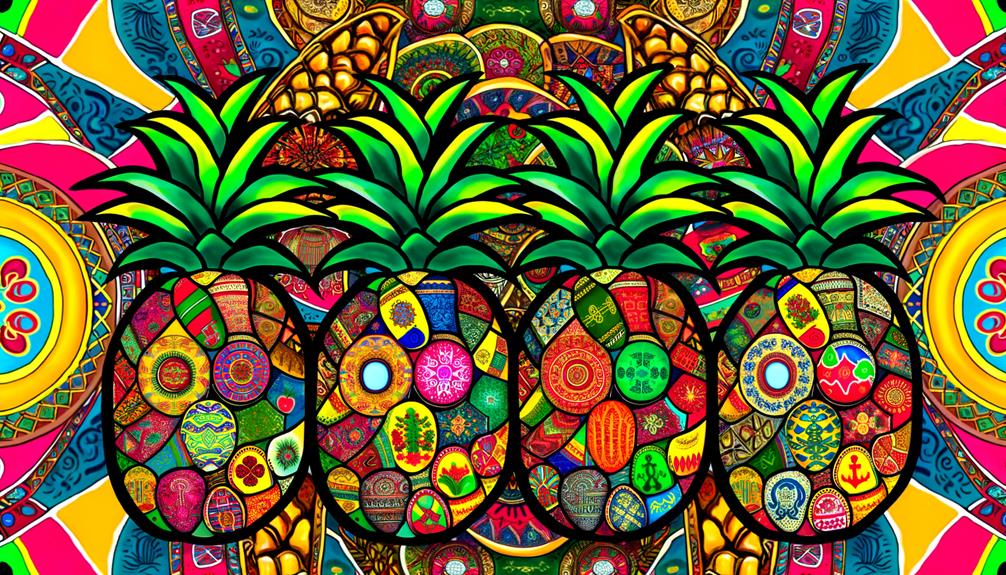What Do Pineapples Symbolize in Western Culture?
Pineapples have rich symbolic significance, rooted in their history as exotic and luxurious commodities. In the 15th century, they were rare treasures from the Americas, representing high social status and wealth, particularly in Europe and Colonial America.
They became iconic symbols of hospitality, frequently displayed at social gatherings to denote generosity and a warm welcome. This trend continued into various cultural contexts, where pineapples also symbolized prosperity, good fortune, and opulence.
Their depiction in art, architecture, and modern decor underscores their sustained allure and cultural reverence. Explore more to uncover the multifaceted symbolism of this intriguing fruit.

Key Takeaways
- Pineapples symbolize hospitality and a warm welcome.
- They represent wealth and social prestige historically.
- In various cultures, pineapples signify prosperity and good fortune.
- The fruit is a cultural icon of opulence and exoticism.
- Pineapples are a visual metaphor for inclusivity and generosity.
Historical Significance

The historical importance of pineapples can be traced back to the 15th century when European explorers first encountered the fruit in the Americas and brought it back to the Old World.
This exotic fruit quickly became a symbol of luxury and hospitality due to its rarity and the difficulty of transportation. Aristocrats and royalty displayed pineapples at feasts and gatherings to demonstrate wealth and generosity.
The fruit's unique appearance and sweet flavor captivated European society, embedding it into cultural and artistic symbols. Over time, the pineapple evolved into an emblem of opulence and welcome, influencing architectural motifs and decorative arts.
Its symbolic interpretation therefore reflects a blend of newfound discovery, economic status, and social customs of the early modern era.
Colonial America
In Colonial America, the pineapple transcended its status as a mere fruit to become a potent symbol of hospitality and social prestige. Imported from the Caribbean, pineapples were rare and expensive, making them a luxurious commodity. Displaying a pineapple at gatherings signified the host's wealth and ability to procure exotic goods, enhancing their social standing.
This fruit's exotic nature and limited availability contributed to its symbolic value. Colonial hosts would often rent pineapples for display, underscoring their desire to project an image of opulence and generosity. Consequently, the pineapple evolved into a cultural emblem, representing not only the host's affluence but also their commitment to welcoming and impressing guests, reflecting broader societal values of the era.
Symbol of Hospitality

Throughout history, the pineapple has consistently been revered as a powerful emblem of hospitality, extending beyond mere decoration to embody the essence of warm and generous reception. This symbolism dates back to the 17th century when pineapples were rare and exotic treasures, often used by colonial hosts to signify their wealth and attentiveness to guests.
The fruit's rarity and expense made it a luxurious offering, signaling the host's desire to provide the highest level of care and welcome. As a result, the pineapple became synonymous with hospitality, often featured in architectural motifs, home decor, and social gatherings. Its presence served as a visual metaphor for the host's goodwill and the promise of a welcoming and generous experience.
Cultural Representations
Across various cultures, the pineapple has evolved into a multifaceted symbol, reflecting diverse interpretations and significances that extend far beyond its initial association with hospitality.
In European traditions, the pineapple signified wealth and exclusivity, often adorning elite gatherings.
Indigenous cultures in the Americas revered it as a symbol of fertility and prosperity.
In Asia, particularly in China, the pineapple is a harbinger of good fortune, commonly featured in celebrations to invoke prosperity.
The fruit's unique appearance and rarity contributed to its exotic allure, shaping its symbolic roles across the globe.
This rich tapestry of meanings underscores the pineapple's enduring legacy as a cultural icon, seamlessly integrating historical associations with evolving cultural narratives.
Pineapples in Art

The pineapple's rich symbolic heritage finds further expression in the domain of art, where its distinct form and vibrant imagery have been celebrated across various mediums and historical periods.
In the 17th and 18th centuries, European artists depicted pineapples as symbols of wealth and hospitality, often including them in still life paintings to signify opulence. This period saw pineapples adorning architectural elements, reflecting their status as exotic and luxurious items.
In colonial America, pineapples appeared in decorative arts, such as carvings and textiles, symbolizing welcome and prosperity. Contemporary artists continue to explore the pineapple's aesthetic and symbolic dimensions, utilizing its form to evoke themes of tropical allure, cultural exchange, and social warmth.
The enduring presence of pineapples in art underscores their multifaceted significance.
Modern Home Decor
In contemporary home decor, the pineapple has emerged as a symbol of tropical elegance and hospitality, reflecting its historical role as a sign of welcome and opulence.
This vibrant motif frequently accents spaces to create inviting atmospheres and bold, eye-catching patterns that speak to a blend of tradition and modernity.
The pineapple's enduring symbolism continues to resonate, making it a popular choice for those seeking to infuse their homes with both warmth and sophistication.
Tropical Elegance Statement
Embracing the pineapple as a symbol of tropical elegance in modern home decor reflects its historical significance as a mark of hospitality and opulence.
Originating from the Americas, pineapples were once rare and expensive, symbolizing wealth and luxury when displayed by European elites.
Today, this emblematic fruit transcends its colonial roots to become a design statement, merging historical richness with contemporary aesthetics.
Pineapple motifs in decor—ranging from intricate wallpaper patterns to sculptural objects—invoke a sense of exoticism and refined taste.
Their presence in modern interiors not only pays homage to their storied past but also embodies a timeless sophistication, seamlessly integrating a touch of the tropics into diverse design styles.
This symbolic fusion of history and modernity elevates any space.
Welcoming Vibes Accent
Building upon the pineapple's historical connotations of luxury and hospitality, its contemporary role as a beacon of welcoming vibes in modern home decor further accentuates its enduring symbolism.
In the 17th century, pineapples were rare and expensive, reserved for the elite as a symbol of opulence and warmth. Today, this emblematic fruit has evolved into a versatile design motif, adorning entryways, living spaces, and kitchens.
Its presence in home decor—whether through sculptures, prints, or textiles—instills a sense of warmth and hospitality, inviting guests to feel at home.
This modern adaptation maintains the pineapple's historical essence, connecting past and present, and continuing to convey a heartfelt message of welcome and generosity in contemporary interiors.
Bold Pattern Trends
Reflecting current preferences while echoing historical opulence, bold pineapple patterns have emerged as a significant trend in modern home decor, symbolizing both liveliness and a welcoming spirit. Historically, pineapples have represented hospitality and luxury, tracing back to their European introduction in the 17th century. Today, their vibrant designs resonate with a desire to infuse homes with warmth and energy.
- Historical Opulence: Pineapples were once rare and costly, signifying richness.
- Symbol of Hospitality: Traditionally, displaying a pineapple indicated a hospitable welcome.
- Tropical Aesthetics: Pineapple patterns evoke exotic, invigorating environments.
- Cultural Icon: Continues to be a multilayered symbol in various cultures.
- Modern Attraction: Bold designs align with current preferences for eclectic and lively interiors.
Through these layers of meaning, pineapples enrich spaces with symbolic depth.
Global Perspectives

Throughout history and across diverse cultures, the pineapple has evolved to symbolize a variety of meanings ranging from hospitality in the Americas to wealth and luxury in Europe.
In colonial America, the pineapple became a symbol of welcome and friendship, often displayed at social gatherings to signify gracious hospitality.
Conversely, in 17th-century Europe, pineapples were rare and expensive, symbolizing opulence and high status; they were frequently showcased in art and architecture as emblems of prestige.
In Asian cultures, particularly in China, the pineapple is viewed as a symbol of prosperity and good fortune, often used in celebrations and ceremonies.
Hence, the pineapple's symbolism is multifaceted, reflecting cultural values and historical contexts unique to each region.
Pineapples in Cuisine
Widely cherished for their unique flavor and versatility, pineapples have played a significant role in culinary traditions around the world, often serving as both a staple ingredient and a symbol of cultural significance. In the context of cuisine, pineapples have transcended mere ingredients to become emblematic of various cultural narratives.
Historically, pineapples symbolized luxury and exoticism in European banquets, while in tropical regions, they represent hospitality and abundance. Their inclusion in diverse dishes—from savory to sweet—showcases their adaptability and enduring appeal.
- Luxury and Opulence: Historically reserved for the elite in Europe.
- Hospitality: Frequently used as a welcoming gesture in tropical cultures.
- Culinary Versatility: Found in sweet desserts, savory dishes, and beverages.
- Cultural Fusion: Integral in both traditional and modern fusion cuisines.
- Symbol of Abundance: Often associated with prosperity in various cultures.
Contemporary Symbolism

In contemporary culture, the symbolism of pineapples has evolved to signify hospitality and a warm welcome, a tradition rooted in colonial American practices.
This emblem has permeated modern social media trends, where the pineapple frequently appears as an icon of friendliness and openness.
Additionally, artists and designers draw inspiration from its distinctive form and vibrant colors, incorporating it into modern art as a symbol of tropical allure and exoticism.
Hospitality and Warm Welcome
How has the pineapple, a fruit once rare and exotic, evolved into a contemporary symbol of hospitality and a warm welcome?
Historically, its scarcity and unique appearance made it a luxurious gift, often displayed at gatherings to signify the host's generosity.
Today, the pineapple symbolizes hospitality through its pervasive use in home décor, culinary presentations, and even in the logos of hospitality businesses. This evolution reflects deeper cultural values:
- Historical prestige: Rooted in its 17th-century rarity.
- Culinary delight: Frequently used in festive dishes.
- Home décor: Emblematic in welcoming spaces.
- Commercial branding: Adopted by hotels and inns.
- Cultural resonance: Universally recognized symbol of warmth.
This transformation underscores the pineapple's enduring role as a beacon of welcome and conviviality.
Social Media Trends
As the pineapple's symbolism of hospitality has flourished through centuries, its presence has permeated social media platforms, where it continues to represent warmth and welcome in the digital age.
This historical emblem of graciousness now features prominently in memes, home decoration posts, and lifestyle blogs, reflecting its enduring appeal. The pineapple emoji has become a shorthand for friendliness and open-heartedness, echoing its long-standing cultural connotations.
The widespread sharing of pineapple imagery on platforms like Instagram and Pinterest underscores its role in modern digital communication, serving as a visual metaphor for inclusivity and conviviality.
Consequently, the pineapple seamlessly shifts from colonial-era drawing rooms to contemporary digital spaces, maintaining its symbolic resonance in an ever-evolving social context.
Modern Art Inspiration
Frequently serving as a muse in modern art, the pineapple's rich symbolism is adeptly reimagined by contemporary artists to explore themes of hospitality, cultural exchange, and exoticism.
Historically, pineapples were rare and highly prized, often signifying wealth and social status. Today, their vibrant imagery transcends mere decoration, becoming a versatile symbol imbued with deeper meanings.
- Hospitality: Emblematic of warm welcomes and gracious hosting.
- Cultural Exchange: Representing the blending of cultures through global trade.
- Exoticism: Evoking a sense of the unfamiliar and the allure of distant lands.
- Wealth and Status: A nod to their historical value and luxury.
- Resilience: Symbolizing strength and endurance, reflected in their tough exterior.
This multifaceted symbolism continues to inspire and resonate in contemporary artistic expressions.
Conclusion
The pineapple, with its storied past, stands as a beacon of hospitality and warmth, transcending mere fruit to embody a rich tapestry of cultural significance.
From its revered status in Colonial America to its pervasive presence in modern decor, the pineapple symbolizes welcome and prosperity.
This emblem of conviviality bridges art, cuisine, and global traditions, offering a sweet reminder of the enduring human desire for connection and well-being.
The pineapple, consequently, remains a poignant symbol of graciousness and unity.





